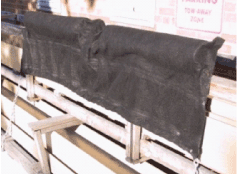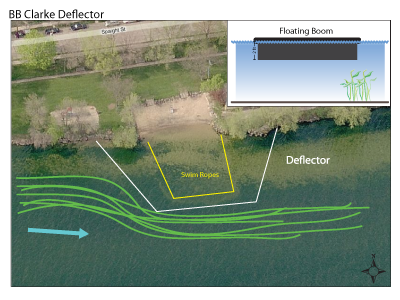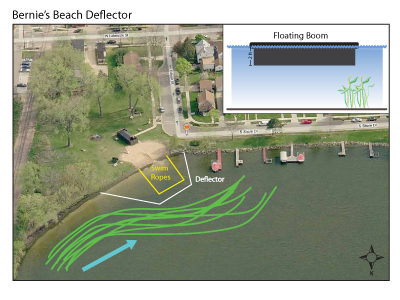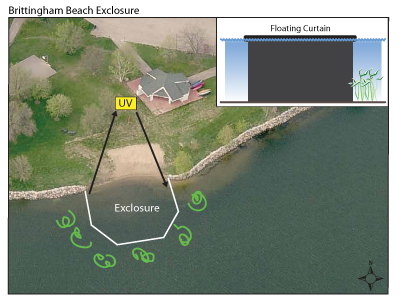Algae
Pilot Study to Reduce Algae Scums at Two Local Beaches

Floating algae scums are a common sight along shorelines in the nutrient-rich Yahara lakes during the summer months. These scums occur after excessive growths or "blooms" of blue-green algae (cyanobacteria) develop; some forms of the algae then become buoyant under relatively calm conditions before being pushed by moderate winds to shore where the algae pile up. Local governmental agencies and concerned citizen groups are currently trying to control algae blooms in the Yahara lakes by reducing the overall level of nutrients entering the lakes from agricultural and urban runoff pollution. Meanwhile, trying to control where potentially toxic algae scums accumulate is a step towards improving the experience of lake-users while these other, more long-term efforts are underway.

In the Yahara Lakes, water circulation patterns induced by moderate winds cause the algal scums to be blown from one site to another until either strong winds break the scums apart or until the algae ultimately decomposes and sinks to the lake bottom. Specifically, long-shore currents (currents in the lake that more or less travel along the shoreline) tend to move the scums along the shore rather than out into the middle of the lake, which is why the scums are so noticeable from the shore. The goal of this pilot study is to see if by installing a floating boom-and-curtain system in the water, algae scums can be kept away from swimming areas, ultimately reducing the number of beach closures.



The geotextile fabric boom system will consist of a floatation collar (about 8-inches in diameter) and a curtain that hangs about 18 inches below the surface. The boom system will be installed in a trapezoidal shape with the base of the trapezoid being the shoreline and the other 3 sides being booms located beyond (outside) the swimming ropes. This obtuse angle design of the boom walls with the shoreline will cause the algal scums and other floating debris moving by longshore currents to be "deflected" away from either side of the beach swimming area regardless of wind direction. Because the boom curtain is designed to only prevent floating debris from entering the swimming area, cleaner water will still pass and circulate underneath the boom to ensure fresh conditions in the swimming area. Water quality monitoring will take place 2 times per week both inside and outside the boom system in several locations to determine its effectiveness. Water velocity will also be measured in several locations to validate a lake circulation model that was used in the design of the system. In 2010, the floating booms were installed at BB Clarke Beach and Bernies Beach. In 2011, the booms have been installed at these beaches for a second year due to promising results in 2010 and great support from the community.
In addition to the floating booms, a floating boom with a curtain that extends to the lake bottom will be installed at Brittingham Beach in Monona Bay. This pilot project is designed to evaluate reducing both algae and bacteria levels at the beach. This site consists of a treatment system that pumps water from inside the "exclosure" through filtration and then through UV disinfection, then releasing treated water back into the swimming area. In order to provide proper treatment, all water must circulate through the system to reduce the level of contamination at the beach. To provide real-time information and test its effectiveness a Real Time Water Imaging System (RTWIS) developed by the University of Wisconsin Madison will be integrated.
All three projects are experimental projects to evaluate strategies to provide cleaner and safer beaches by reducing exposure to toxic algae and bacteria.






